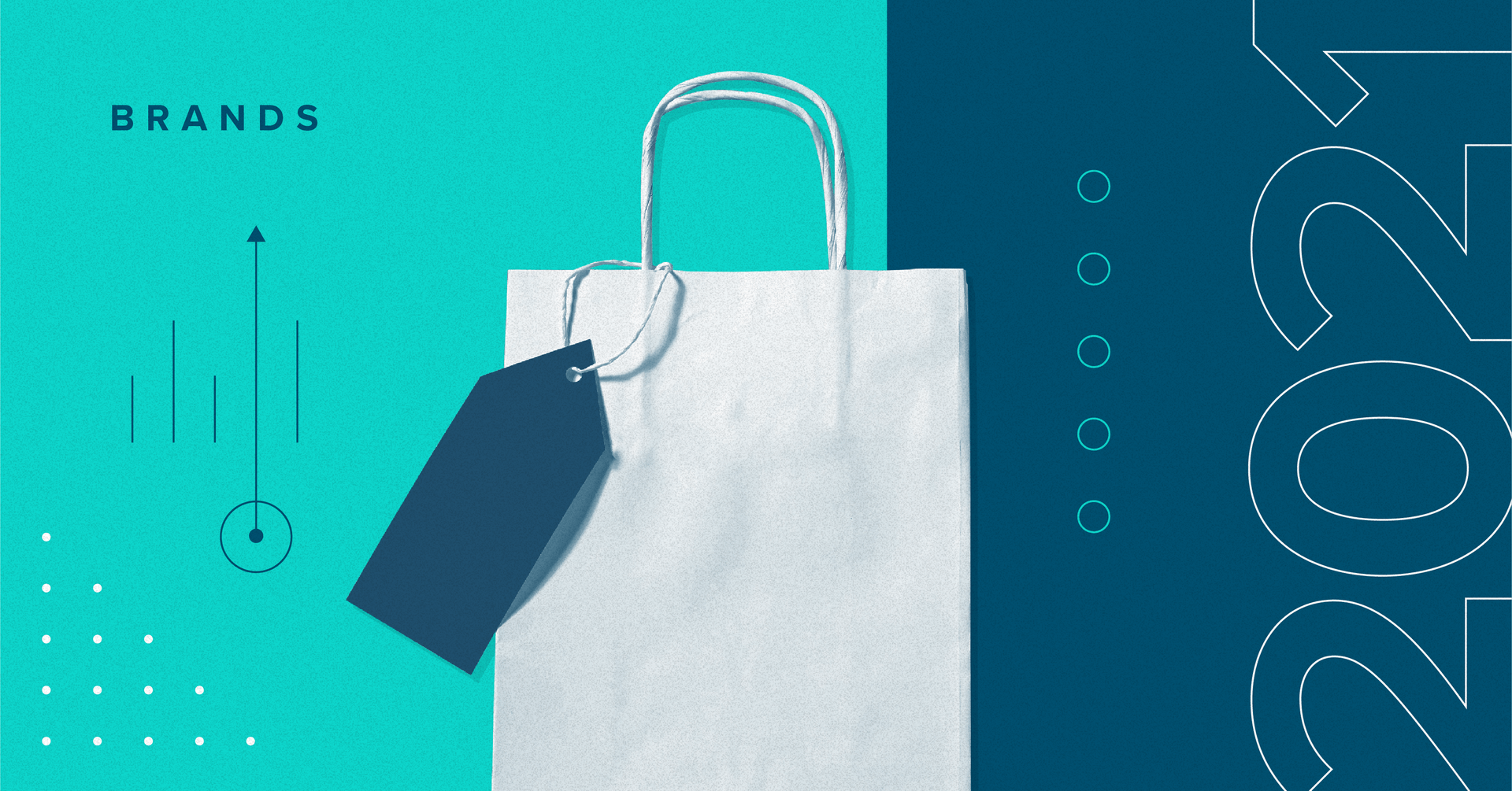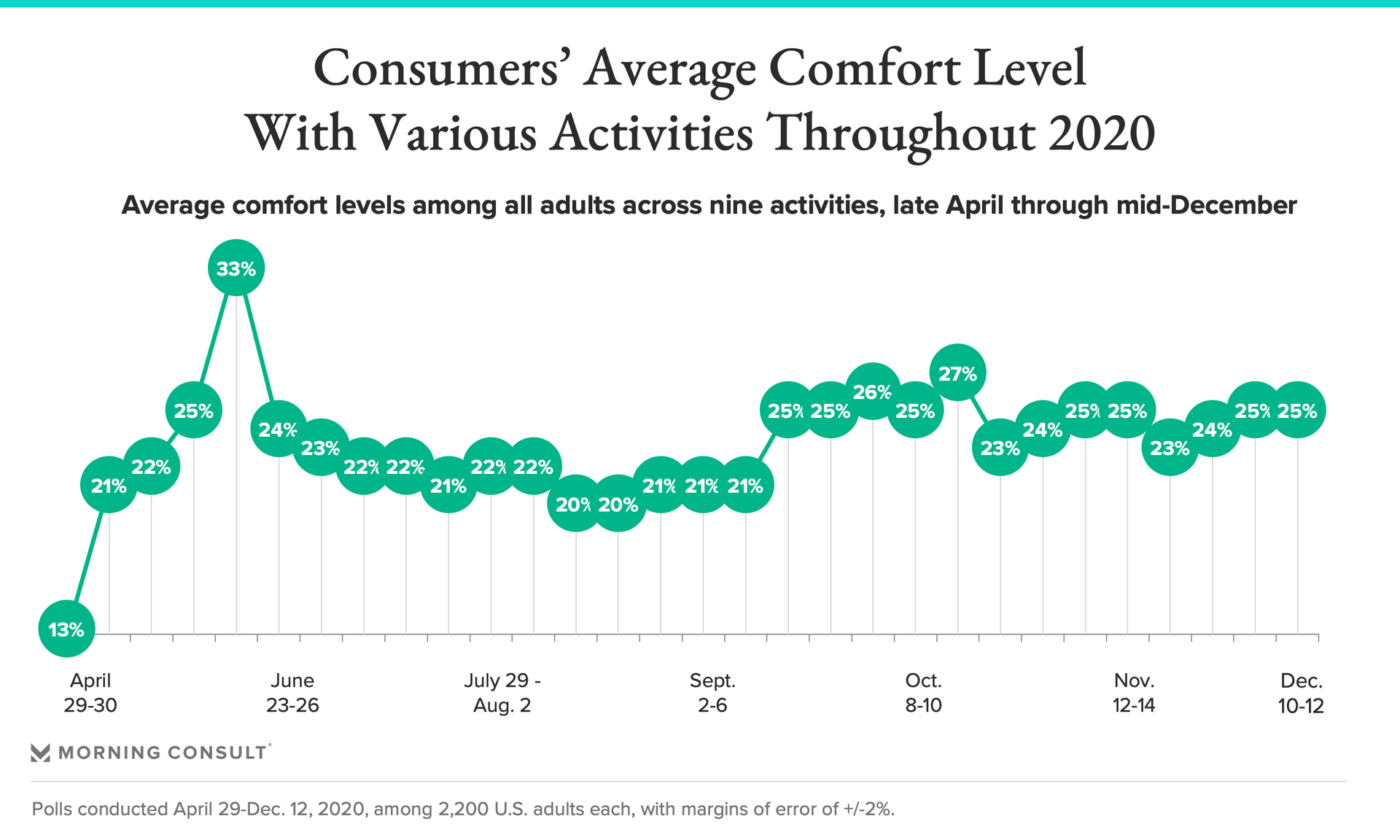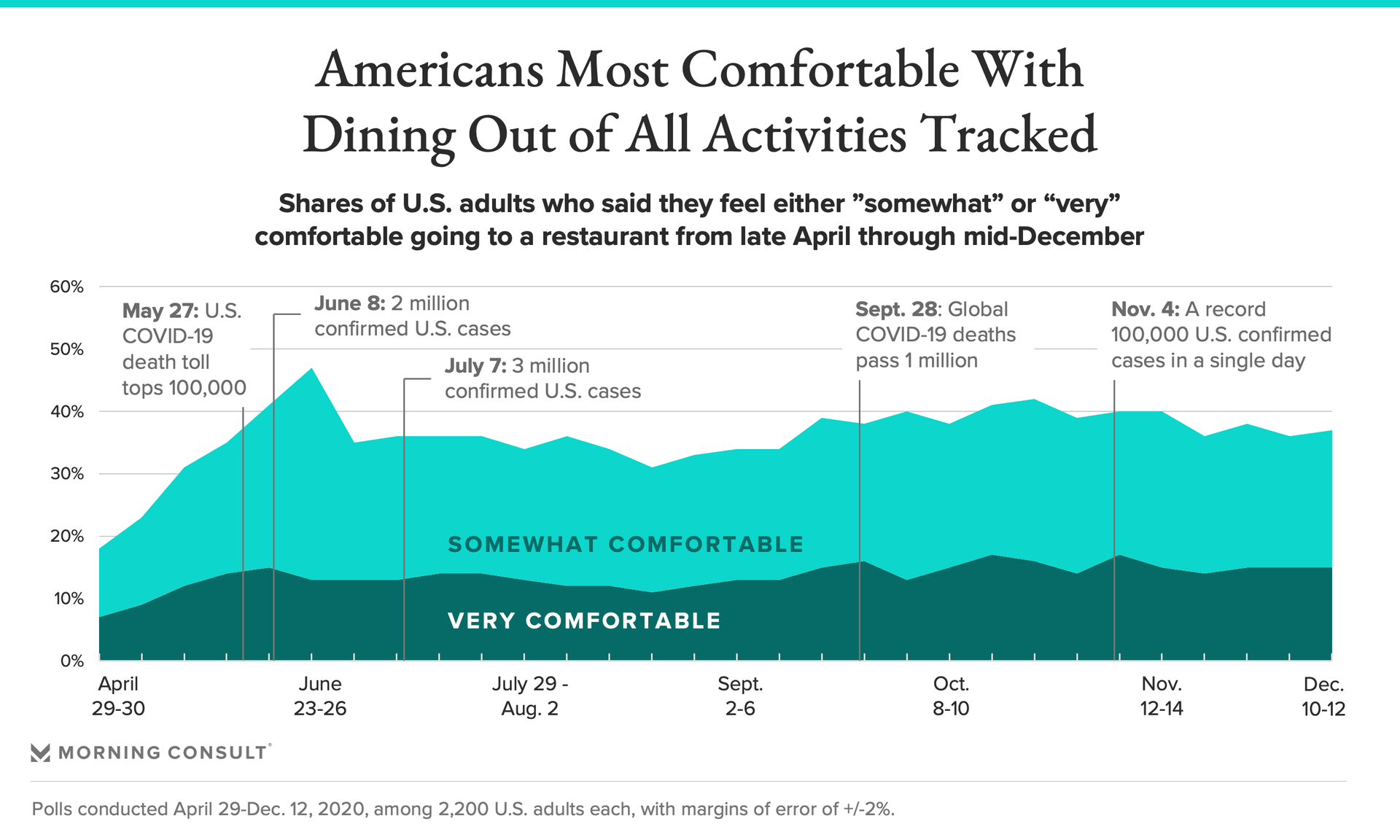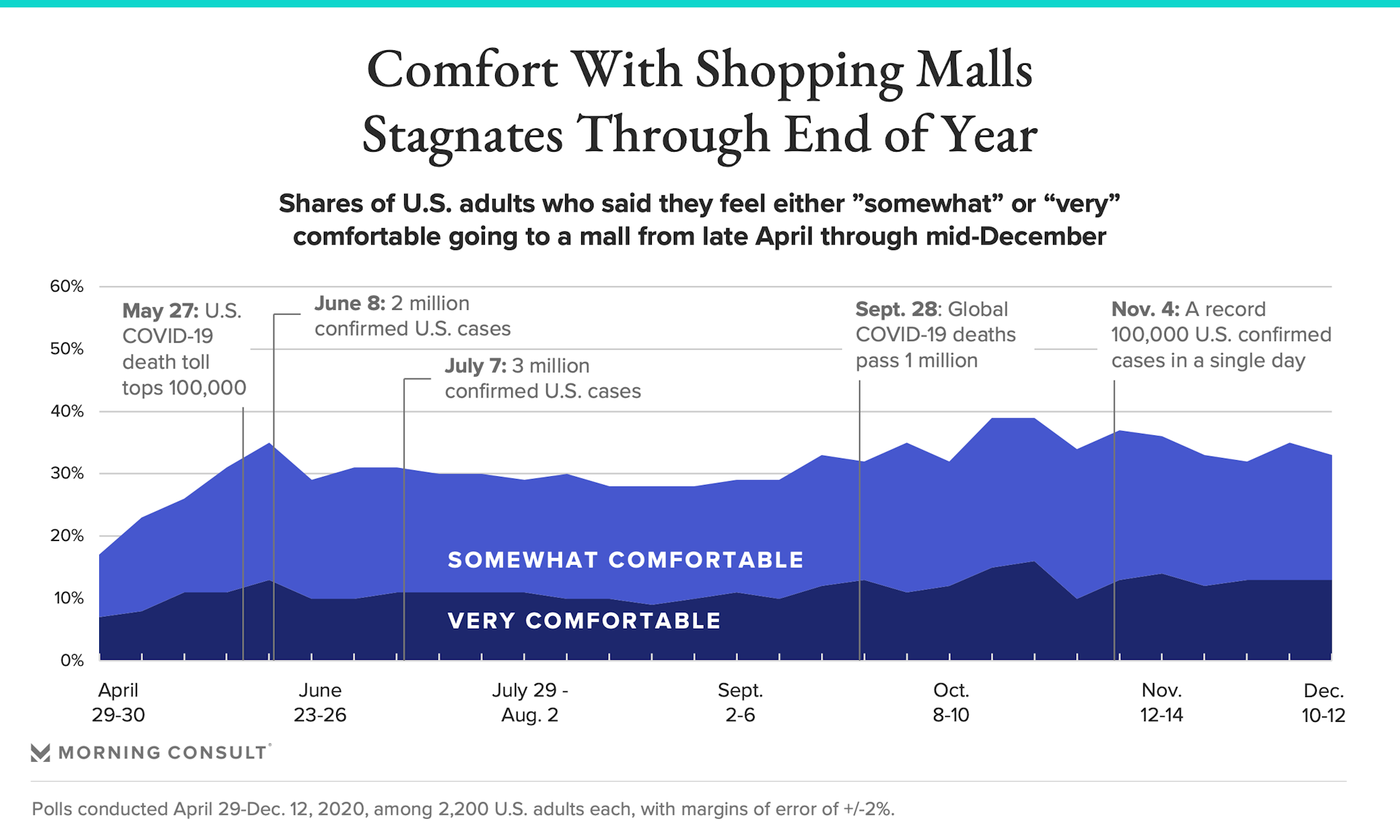A Look Back at Consumer Comfort Trends Through 2020, and What to Expect Next Year

Key Takeaways
Since comfort levels dropped in June, average comfort has yet to climb higher than 27% of U.S. adults who say they feel safe doing the activities tracked by Morning Consult.
Experts anticipate the start of a return to normalcy by summer or fall, but say consumer behavior won’t automatically match pre-pandemic trends.
As we near the end of a year that has upended life as we know it, Morning Consult is looking ahead to what 2021 will bring. Alyssa Meyers reports on consumer comfort trends. Others in our end-of-year series so far: Entertainment / Health / Tech
As the coronavirus shut down American life, consumer-facing companies, struggling to stay afloat as the public hunkered down in their homes, were all asking the same question: When will consumers feel safe to return to everyday life?
Morning Consult has been checking in with consumers every week since April, gauging their comfort levels with a variety of leisure activities. To round out 2020, we’re taking a closer look at how the public's safety levels shifted over the year, and what 2021 might bring.

Morning Consult began tracking the public’s comfort levels in late April, seven weeks after the World Health Organization declared COVID-19 a pandemic. At the time, few U.S. adults said they felt safe traveling or visiting businesses, but comfort began to creep up for about two months, before roughly leveling off for the remainder of the year.
The public’s comfort levels in 2021 will tie in closely to the continued rollout of vaccines, which will likely make people feel more comfortable returning to pre-pandemic habits. Industry experts said that while summer or fall could prove to be turning points, consumers, brands and marketers should anticipate at least another year of abnormal consumer behavior to some extent.
Even beyond next year, major companies in particular will continue to face obstacles as they try to accommodate varying levels of comfort.
Dr. Tista Ghosh, senior medical director and epidemiologist for the California-based health care company Grand Rounds, said that considering the current state of vaccine availability, it’s reasonable to estimate that it will take until about the fall to achieve herd immunity, or the point at which enough of the population has been vaccinated to assume Americans are generally protected from the virus.
After health care workers, essential workers and high-risk individuals are vaccinated, general population vaccination will commence. This phase is projected to occur over the summer, Ghosh said.
The process might happen faster given government policy changes or vaccine advancements from other pharmaceutical companies, which seem imminent, Ghosh said. Once a significant portion of the population is vaccinated, consumer behavior is anticipated to begin returning to normal. But until then, comfort isn’t likely to change significantly.
“If most people don’t have the vaccine, you still have those concerns that you can spread it and get someone else sick, even though you yourself might be protected,” Ghosh said. “There’s an element of social consciousness that will keep people from feeling comfortable.”

Dining out, the activity Americans have been most comfortable with since Morning Consult began its tracking, has followed a similar pattern to the average across activities. Comfort reached a record high in late October, when 42 percent of the public said they felt safe dining out. After leveling off around 40 percent in November, that number has hovered in the high 30-percent range this month.
Restaurants won’t benefit from vaccine-induced consumer comfort shifts until warmer temperatures arrive in the spring, according to Amit Mehrotra, an assistant professor in the New York City College of Technology’s hospitality management department.
“Even when we reach herd immunity, I think people will return in numbers, but not in mass numbers,” Mehrotra said. “Restaurants may do slightly better this summer, but I don’t think we’re going to get back to pre-pandemic levels by then, or even in 2021.”
Prompted by warm weather and low case counts, the public gathered in higher numbers on Labor Day, which could have marked a turn for the worse, said Victoria Sakal, managing director for brand intelligence at Morning Consult.
“Those circumstances made people feel comfortable,” Sakal said. “There was also an element around that six-month mark of people starting to feel ready to get back to life and embrace those things they might have felt less comfortable with when the outbreak first hit us in March.”
Similar scenarios, such as the return of warm weather, will comfort the public this spring, and once again, consumers might become less vigilant and more willing to resume some normal activities, according to the experts.
Assuming the vaccine rollout has continued success, there might not be another spike in cases at that time, Ghosh said, though some states could face trouble if temperatures rise too high in the summer.
“In places where the weather allows people to have outdoor activities, we might not see as much as a surge because outdoor transmission is lower,” Ghosh said. “But in places where it’s too hot to be outside in the spring and summer, and people aren’t fully vaccinated enough to get herd immunity, we might see a spike in those places.”
For now, comfort levels continue to vary among different demographics, a trend that’s likely to continue in 2021, Sakal said.
For instance, millennials are growing more comfortable with returning to leisure activities, while baby boomers’ comfort remains fairly low, and might continue to flatline until they’re vaccinated, according to Sakal.

Consumers have been relatively comfortable with visiting shopping malls through the pandemic, at least compared to going to movie theaters or gyms. As of mid-December, one-third of U.S. adults said they felt safe at a mall.
Rodney Sides, vice chairman and U.S. retail, wholesale and distribution leader at Deloitte, said he noticed the same trend in tracking comfort regarding going to a store: 56 percent of respondents said they feel safe doing so, as of Deloitte’s most recent update, with the share of consumers expressing comfort declining slightly or remaining the same in the weeks since Thanksgiving.
The trend is concerning for brick-and-mortar retailers, Sides and Sakal agreed, but doesn’t spell the death of the in-person shopping experience.
“Folks will come back to stores,” Sides said, “but we won’t ever reach pre-COVID levels.”
Consumers’ familiarity with brick-and mortar operations and their desire to test out items before buying them are likely protecting in-store appeal, even as they continue to embrace the convenience of online shopping, which “has been far and away a more popular choice for shoppers in the context of the holiday season,” Sakal said.
Comfort won’t systemically change until vaccines become more widely available, and even then, it will take time for consumers to feel as safe in public as they did before the pandemic.
“There are visual cues they’ll still need to have in stores, and contactless payment options, and delivery options for slower-to-get-back audiences, while also having messaging for people who have been missing these things,” Sakal said. “You’re going to have to be there for different types of customers in different types of ways.”
Alyssa Meyers previously worked at Morning Consult as a reporter covering brands and marketing.